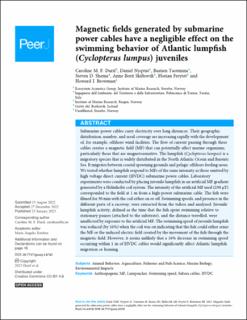Magnetic fields generated by submarine power cables have a negligible effect on the swimming behavior of Atlantic lumpfish (Cyclopterus lumpus) juveniles
Durif, Caroline; Nyqvist, Daniel; Taormina, Bastien; Shema, Steven; Skiftesvik, Anne Berit; Freytet, Florian; Browman, Howard
Peer reviewed, Journal article
Published version
Permanent lenke
https://hdl.handle.net/11250/3102175Utgivelsesdato
2023Metadata
Vis full innførselSamlinger
- Articles [3009]
- Publikasjoner fra CRIStin [3056]
Sammendrag
Submarine power cables carry electricity over long distances. Their geographic distribution, number, and areal coverage are increasing rapidly with the development of, for example, offshore wind facilities. The flow of current passing through these cables creates a magnetic field (MF) that can potentially affect marine organisms, particularly those that are magnetosensitive. The lumpfish (Cyclopterus lumpus) is a migratory species that is widely distributed in the North Atlantic Ocean and Barents Sea. It migrates between coastal spawning grounds and pelagic offshore feeding areas. We tested whether lumpfish respond to MFs of the same intensity as those emitted by high voltage direct current (HVDC) submarine power cables. Laboratory experiments were conducted by placing juvenile lumpfish in an artificial MF gradient generated by a Helmholtz coil system. The intensity of the artificial MF used (230 µT) corresponded to the field at 1 m from a high-power submarine cable. The fish were filmed for 30 min with the coil either on or off. Swimming speeds, and presence in the different parts of a raceway, were extracted from the videos and analyzed. Juvenile lumpfish activity, defined as the time that the fish spent swimming relative to stationary pauses (attached to the substrate), and the distance travelled, were unaffected by exposure to the artificial MF. The swimming speed of juvenile lumpfish was reduced (by 16%) when the coil was on indicating that the fish could either sense the MF or the induced electric field created by the movement of the fish through the magnetic field. However, it seems unlikely that a 16% decrease in swimming speed occurring within 1 m of HVDC cables would significantly affect Atlantic lumpfish migration or homing.
